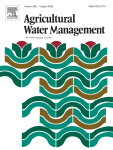Ver ítem
- xmlui.general.dspace_homeCentros Regionales y EEAsCentro Regional Buenos Aires SurEEA BalcarceArtículos científicosxmlui.ArtifactBrowser.ItemViewer.trail
- Inicio
- Centros Regionales y EEAs
- Centro Regional Buenos Aires Sur
- EEA Balcarce
- Artículos científicos
- Ver ítem
Maize transpiration efficiency increases with N supply or higher plant densities
Resumen
Most of the studies addressing the influence of management practices on seasonal crop water use efficiency (i.e., the ratio between shoot biomass and evapotranspiration in a seasonal scale, WUE(B, ET, s)) have focused on their effect on evaporation. Processes specifically related to the crop transpiration component received less attention as possible mechanisms underlying WUE(B, ET, s) responses. In this study, we provide empirical evidence in support to
[ver mas...]
Most of the studies addressing the influence of management practices on seasonal crop water use efficiency (i.e., the ratio between shoot biomass and evapotranspiration in a seasonal scale, WUE(B, ET, s)) have focused on their effect on evaporation. Processes specifically related to the crop transpiration component received less attention as possible mechanisms underlying WUE(B, ET, s) responses. In this study, we provide empirical evidence in support to theoretical predictions on how agronomic management practices such as N supply or plant density changes modify maize (Zea mays L.) transpiration efficiency for shoot biomass production (i.e., the ratio between shoot biomass and transpiration in a seasonal scale, WUE(B, T, s)); and determine the contribution of crop conductance (gc) and radiation use efficiency (RUEB) to the response of WUE(B, T, s) to these management practices. Maize crops were grown at Balcarce, Argentina during four seasons. Treatments included two rates of N (i.e., 120 kg N ha−1 or non-fertilized during Seasons 1 and 2) or three plant densities (4, 8 and 12 plants m−2 with no N limitations, during Seasons 3 and 4). Measurements comprised (i) soil water content, evaporation and intercepted photosynthetically active radiation (iPAR) during the whole crop season, and (ii) shoot dry matter at physiological maturity (PM). Crop evapotranspiration (ET) was calculated by means of a water balance and soil evaporation (E) was estimated with micro-lysimeters. Crop transpiration (T) was estimated as the difference between ET and E; RUEB and WUE(B, T, s) were estimated from the ratio between crop biomass at PM and seasonal iPAR or T, respectively; and gc was estimated as T/iPAR (mm MJ−1). Higher N supply and plant densities positively affected WUE(B, ET, s) of maize crops, by increasing WUE(B, T, s) (ca. 19% for N supply and 8–12% for plant density) in addition to decreasing soil water evaporation. Changes in WUE(B, T, s) due to N supply were accounted by RUEB changes while gc was the main trait contributing to WUE(B, T, s) response to plant density. Crop conductance significantly decreased with maximum LAI increments up to 3.9. This work highlights the importance of considering crop conductance changes in response to management practices such as changing plant density.
[Cerrar]

Autor
Fuente
Agricultural Water Management 250 : 106816 (2021)
Fecha
2021-03-08
Editorial
Elsevier
ISSN
0378-3774
Formato
pdf
Tipo de documento
artículo
Palabras Claves
Derechos de acceso
Restringido
 Excepto donde se diga explicitamente, este item se publica bajo la siguiente descripción: Creative Commons Attribution-NonCommercial-ShareAlike 2.5 Unported (CC BY-NC-SA 2.5)
Excepto donde se diga explicitamente, este item se publica bajo la siguiente descripción: Creative Commons Attribution-NonCommercial-ShareAlike 2.5 Unported (CC BY-NC-SA 2.5)

